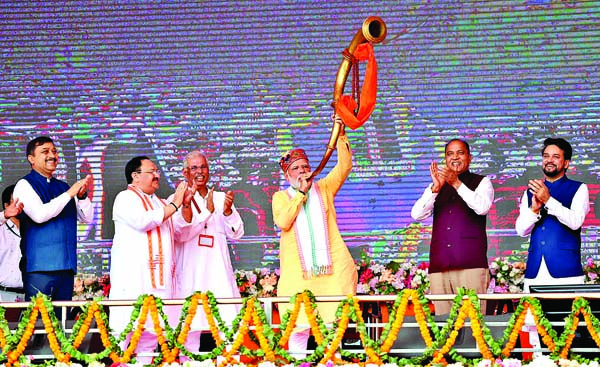Kullu Dussehra is known for its grandeur and popular enthusiasm across the country. The scenic beauty of the place, all decked up Rath Yatra, the milling crowd, and the chants have been a great attraction from time immemorial. But it had never drawn the Prime Minister of the country to its charm until October this year when Narendra Modi decided to participate in the joyous festival.
It goes without saying that he would have given heed to the advice of security agencies. Being there meant that Prime Minister Modi was going to be at a ground where people occupied every single inch and where no security barricades could be erected for his protection. He was going to be one among them. An election or no election, his move conveyed two very important messages to the people of Himachal Pradesh – first, he took pride in its civilisational and cultural legacy and wanted to give a greater push, along with other developmental aspects. He had gone there after inaugurating a modern multi-speciality AIIMS in Bilaspur, laying foundation stones, and inaugurating a series of other developmental projects in this Himalayan State.

Second, security protocols were not a barrier for him to be among his people. His presence hugely enthused people and has been a talking point since then. Since this is election time in the State and people of the region have deep emotion connected with their cultural symbols, more so with the unique Kullu Dussehra, its implications are bound to shape the voting preferences of sections of people favouring the BJP.
Himachal Pradesh so far has an electoral tradition of exiting the incumbent in the election after every five years. Some take this as an easy route to predict the possible outcome of this election. The Congress and its supporters make a further addition to this analysis that in by-elections held last year, the ruling BJP lost Mandi parliamentary and three assembly seats to the Congress.
Two things are important here. First, the by-election results are never a pointer to the mood of the voters in general elections. By-election results in Uttar Pradesh for the last ten years and results of two parliamentary and two assembly elections in this period are a case in point. Last year’s by-elections rang alarm bells in the BJP, and it is more than evident that its leadership took notice of that. On the other hand, Congress became complacent, and its so-called High Command went into a sleep mode.
Second, the BJP, since 2014 is a new BJP; it has acquired a different vigour, far more energetic both in terms of strategy and implementing its planning on the ground. It neither becomes complacent in favourable situations nor loses heart in adverse conditions, least of all data analysis five-year rotation. It has grown an amazing appetite to fight and win. Armchair analysts and all their theories proved wrong in Uttrakhand, Uttar Pradesh, Assam and elsewhere. Early this year, Uttrakhand was a unique case where the BJP practically snatched a comfortable victory in the closing months out of the jaws of an almost imminent defeat. One understands that each election is different, but the only limited point here is simple—one should begin looking at Himachal Pradesh elections by discounting the five-year rotation thought.
Let’s consider the situation on the ground, and begin with Congress, the perceived main challenger. It begs a straightforward question—is Congress serious about these elections? In the run-up to elections in Himachal Pradesh and Gujarat, and when his party was breaking up all over, across different states, the de-facto boss of the party, Rahul Gandhi, embarked on a Bharat Jodo Yatra. The entire party machinery is busy managing that re-re-re-re launch of Rahul. The rest of the party establishment was busy conducting a sham internal election to thrust a Gandhi proxy, Mallikarjun Kharge, to the president’s post, relinquished by Gandhi after close to two-and-half-decades. The central party in-charge of Himachal elections was till recently with a BCCI nomination for self than here.
Priyanka’s Flop show
Priyanka Gandhi Vadra lately landed in parts of Himachal Pradesh. She is more focused on reminding who she was – the granddaughter of Indira Gandhi. But then she has nothing substantive to say about what great things Indira did for Himachal Pradesh and why people of the State should still vote for Congress.
In her enthused sense of entitlement, Priyanka forgets that people may make a judgment about the prime land in Shimla, where she has constructed a bungalow. She and her advisors also forget that Indira Gandhi died 38 years ago; thus, anyone under 42-45 years of age wouldn’t recall her former Prime Minister grandma. It remains to be seen how an 80-year-old new Congress president Mallikarjun Kharge brings energy and vigour to campaign in the State.
Another challenger, the Aam Aadmi Party, which made too much sound and fury till a few months ago about Himachal, has now virtually stopped its campaign before the election schedule for the State. AAP’s State president Anup Kesari joined BJP with almost the entire AAP’s newfound organisational set-up. Union Minister Anurag Thakur, a four-time MP from the State, played a key role in inflicting humongous embarrassment to Arvind Kejriwal and his party. AAP’s in-charge for Himachal Pradesh, a Minister in the Kejriwal Government in Delhi, Satyendra Jain, landed in jail money–laundering case and has since not got bail from a court of law.
The BJP, however, is not taking any chances. Besides breaking the five-year rotation electoral norm and thus scripting a new chapter in Himachal political history, this election has another significance for the party. Rebellion by some party leaders, some serving MLAs who were denied tickets and some who aspired for access, surely gave troubled time to the party leadership. The party is working on this.
“Modiji ko campaign ke liye aane dijiye, phir dekhiyega kaise lahar banegi (Let Modiji come and then see how a pro-incumbency wave is built)”, is the refrain among BJP supporters.



















Comments